CLAT PG 2022 Question paper with answer key pdf conducted on June 19, 2022 is available for download. The exam was successfully organized by Consortium of National Law Universities. In terms of difficulty level, CLAT PG was of Tough level. The question paper comprised a total of 120 questions.
CLAT PG 2022 Question Paper with Solution PDF
| CLAT PG 2022 Question Paper PDF | Download PDF | Check Solutions |

CLAT PG 2022 Question Paper with Answer
Both lawmen and laymen often ask, “What is the law applicable to a given set of facts?” The answers to this question differ depending upon the specific jurisdiction to which the given set of facts is linked. Contrary to this, scholars and students of jurisprudence are likely to ask the general question, viz “What is Law?”. This question on the philosophy and nature of law supposes that law is a distinctive social-political phenomenon with universal characteristics that can be perceived through philosophical analysis. In such a study, the assumption is that law possesses some universal characteristics.
Read More
An analysis of the philosophy of law can be done for different reasons. Apart from a purely intellectual interest in understanding this complex phenomenon known as law, scholars also study the same as a normative social practice that purports to guide human behaviour, giving rise to reasons for action. The primary challenge of the branch of scholarship known as jurisprudence is based on this “normative, reason-giving aspect of law”. At the same time, we must understand that law is not the only normative realm in any given society. It is one of the many normative standards such as morality, religion, customs and usages, etiquette, self-regulatory standards within a family or corporation, etc. So, it is also essential that we study law on the differences and similarities of the same with these normative standards.
While discerning these connections and contradictions, legal theories often study the content of the norm apart from giving importance to the source. Generally, theoretical studies on the content such as natural lawyers emphasize values such as fairness, justice, liberty, etc., as qualifications for the norms to be called laws. They have argued that laws must be in tune with certain principles of inner morality, such as that laws be general, public, prospective, coherent, clear, stable, and practicable, which are indispensable to law-making. Whereas theories that give prominence to the sources of the norm, such as enactment/command by political institution/authority, do not always emphasize the content.
Such philosophical analysis of law comprises both explanatory and justificatory aspects. While the explanatory aspect consists of explaining how laws can give rise to reasons and what kinds of reasons are involved, one example of this would be Dworkin’s classification of law as concepts, principles and rules. The aspect of justification concerns whether people ought to comply with the law’s demands. In other words, it is the attempt to explain the moral legitimacy of law and the subjects’ reasons for complying with it.
Question 1:
Validity of law resides in the political sovereignty of the maker of that law refers to:
A norm cannot become legally valid unless its content is fair and just in accordance to:
View Solution
“The falsehood of legal positivism resides in envisaging that the law consists of only rules... The distinction between rules and principles is a logical one...” according to:
View Solution
Principles requiring that laws be general, public, prospective, coherent, clear, stable, and practicable are indispensable to law-making correspond to:
View Solution
‘I mean simply that history, in illuminating the past, illuminates the present, and in illuminating the present, illuminates the future’ opined by:
View Solution
‘The life of the law has not been logic: it has been experience’ is stated by:
View Solution
A thought-provoking book titled The Morality of Law by Lon L. Fuller on moral philosophy insists on a distinction between “morality of aspiration” and “morality of duty”. From the view of the morality of aspiration, human conduct does not bear on mandatory rules but on conceptions of the “Good Life”, of “what beseems a human being functioning at his best to human capacities”. Because no law can compel a man to live up to the excellence of which he is capable. But for workable standards of judgment, the morality of duty lays down the basic rules without which an ordered society directed towards certain specific goals must fail of its mark.
Because the duty ties it very closely to what is “rationally discoverable” and “objective”, as contrasted with the morality of aspiration based on subjectivism. However, moralists may differ as to what range of conduct should fall within the respective spheres of duty and the morality of aspirations. “When we are passing a judgment of moral duty, it seems absurd to say that such a duty can in some way flow directly from knowledge of a situation of fact.” Due to the fact that before we conclude “that a duty ought to exist”, however well we may understand the facts, by the close connection between understanding a person’s ideals, approval and disapproval, it is clear that duties are not purely matters of preference.
Does this mean that duties are rationally discoverable, and a matter of choice, even if not of “ineffable preference”? Presumably not, since when we pass a moral judgment of duty, it “ought” to exist. It is necessary to distinguish between the accepted morality of a social group and the personal morality of individuals. “Duty” may appear in all of these, but the satisfaction is very often a matter of degree varying from situation to situation.
The rule of a morality of duty is necessary for social living. The morality of aspiration provides a general idea of the perfection we ought to acquire. If we consider the whole range of moral issues, we may imagine a yardstick which begins at the bottom with the most obvious demands of social living and extends upward to the highest reaches of human aspirations. Somewhere along this scale an invisible pointer marks the dividing line where the pressure of duty leaves off and the challenge of excellence begins.
The whole field of moral argument is an undeclared war over the location of this pointer. Those we regard as being moralistic are always trying to inch the pointer upward so as to expand the area of duty, bludgeoning us into a belief that we are duty bound to embrace this pattern of human conduct, instead of making us realize a pattern of life they consider worthy of human nature.
Question 7:
Which of the following statements regarding the ‘morality of aspiration’ is untrue?
View Solution
The rules for morality of duty command:
View Solution
Consider the statements:
View Solution
Which of the following element is not required for the formation of decision regarding a moral duty?
View Solution
The concept of duty as characterised by Lon L. Fuller seems:
View Solution
Which of the following statements is not true?
View Solution
The present system of appointments as envisaged by the Constitution and as elucidated in the Collegium system makes it clear that the first step is a recommendation from the Collegium of four senior-most judges and presided over by the Chief Justice. This process in turn requires wide consultation by the Chief Justice of the High Court to identify the requisite talent, so as to make the recommendations.
Contrary to some portrayed beliefs, as if this is an extremely subjective system, every Chief Justice is actually required to solicit names from different sources whether it be sitting judges, retired judges, or prominent members of the Bar. It is from this pool of talent that he selects, after a discussion in the collegium, the most suitable candidates. It is thus of utmost importance that the flow of recommendations continues for the appointment process to work successfully.
The current situation of vacancies, especially in some of the larger courts with very few recommendations in the pipeline, seems to be the genesis of this problem. The data placed before us, as drawn from the National Judicial Data Grid (NJDG), shows that five (5) High Courts alone are responsible for 54% of the pendency of over 57,51,312 cases, i.e., the High Courts of Allahabad, Punjab & Haryana, Madras, Bombay, and Rajasthan. The Madras High Court has among the highest arrears in the country of 5.8 lakh cases despite having fewer vacancies than most other High Courts (i.e., 7%).
This does not take away from the requirement of appointing ad hoc Judges but supports the view that even if the existing vacancies are few, a situation may arise requiring the expertise of experienced Judges to be appointed as ad hoc Judges.
Question 13:
The above excerpt has been taken from which of the following judgments, where the Supreme Court of India sought to activate a dormant provision of the Constitution of India for the appointment of ad hoc Judges to deal with the unprecedented backlog of cases pending before the High Courts?
View Solution
Which of the following dormant provision of the Constitution of India has been invoked by the Supreme Court of India for the appointment of ad hoc Judges to deal with the backlog of cases before the High Courts?
View Solution
In Supreme Court Advocates on Record Association v. Union of India, (2016) 5 SCC 1, the Supreme Court of India, by a ____ majority, restored the collegium system of appointment of judges by holding that the National Judicial Appointments Commission Act, 2014 is ultra vires the Constitution of India.
View Solution
In which of the following cases the Supreme Court of India observed that for appointment of a retired Judge as an ad hoc judge, the consent of such retired Judge is a pre-requisite for his/her appointment as an ad hoc judge?
View Solution
In which of the following reports the Law Commission of India advocated for appointment of retired judges as ad hoc judges in the interest of clearing backlogs of cases in the High Courts?
View Solution
Which of the following statements is true regarding the origin of the Collegium system for appointment of judges?
View Solution
The Supreme Court of India observed that, while appreciating the existence of the right to peaceful protest against a legislation . . . , we have to make it unequivocally clear that public ways and public spaces cannot be occupied in such a manner and that too indefinitely. Democracy and dissent go hand in hand, but then the demonstrations expressing dissent must be in designated places alone.
The present case was not even one of protests taking place in an undesignated area but was a blockage of a public way which caused grave inconvenience to commuters. We cannot accept the plea of the applicants that an indeterminable number of people can assemble whenever they choose to protest.
Question 19:
Which of the following judgments relating to right to peaceful protest has the above excerpt been taken from?
View Solution
Which of the following judgments is not related to right to assemble as enshrined under the Constitution of India?
View Solution
As per the judgment of In Re Ramlila Maidan Incident, (2012) 5 SCC 1, which of the following statement is not correct?
View Solution
Which of the following statement is not correct in relation to right to assemble under the Constitution of India?
View Solution
The rule prohibiting demonstrations by government servants was discussed in which of the following judgments?
View Solution
Which of the following judges of the Supreme Court of India were part of the Bench in the judgment as given in the excerpt?
View Solution
The Supreme Court of India has held that the rationale of granting maintenance from the date of application finds its roots in the object of enacting maintenance legislations, so as to enable the wife to overcome the financial crunch which occurs on separation from the husband. Financial constraints of a dependant spouse hamper their capacity to be effectively represented before the Court.
Enforcement of the order of maintenance is the most challenging issue, which is encountered by the applicants. If maintenance is not paid in a timely manner, it defeats the very object of the social welfare legislation. Execution petitions usually remain pending for months, if not years, which completely nullifies the object of the law.
Question 25:
Based on the given excerpt from the judgment, which of the following judgments is related to enforcement of orders of maintenance and successive claims by parties in matrimonial proceedings?
View Solution
Which of the following reliefs does the Hindu Marriage Act, 1955 provide?
View Solution
Which of the following statutes does not contain provisions relating to maintenance?
View Solution
Which of the following is not a direction given by Supreme Court of India in the judgement relating to orders of maintenance and successive claims by parties in matrimonial proceedings?
View Solution
Which of the following is not correct as per Section 125 of the Code of Criminal Procedure, 1973?
View Solution
Which of the following is correct about the Hindu Adoptions and Maintenance Act, 1956?
View Solution
The Supreme Court of India has held that the nature of inquiry before the Family Court is, indeed, adjudicatory. It is obliged to resolve the rival claims of the parties and while doing so, it must adhere to the norms prescribed by the statute in that regard and also the foundational principle of fairness of procedure and natural justice.
These provisions plainly reveal that the Family Court is expected to follow procedure known to law, which means insisting on a formal pleading to be filed by both sides, then framing the issues for determination, recording the evidence of the parties to prove the facts asserted by the concerned party, and only thereafter entering upon determination and rendering a decision thereon by recording the reasons for such decision.
For doing this, the Family Court is expected to give notice to the respective parties and provide them sufficient time and opportunity to present their claim in the form of pleadings and evidence before determination of the dispute.
Question 31:
Which of the following is not correct about the Family Courts Act, 1984?
View Solution
Based on the given excerpt, which of the following judgments is related to the working of Family Courts?
View Solution
Based on the given excerpt, which of the following was held by the Supreme Court of India in relation to the Family Courts?
View Solution
The Family Court must adhere to the norms prescribed by the statute with regard to the adjudication of matrimonial disputes, and also to the:
View Solution
Which of the following is not correct about the nature of proceedings conducted in the Family Court?
View Solution
The Family Courts Act, 1984 does not apply to which of the following matters?
View Solution
The Supreme Court of India, in South East Asia Marine Engineering & Constructions Ltd. (SEAMEC LTD.) v. Oil India Ltd., (2020) 5 SCC 164, noted that, under the Indian contract law, the consequences of a force majeure event are provided for under Section 56 of the Indian Contract Act, 1872 which deals with a contract to do an act which, after the contract is made, becomes impossible, or, by reason of some event which the promisor could not prevent, unlawful, becomes void when the act becomes impossible or unlawful.
When the parties have not provided for what would take place when an event renders the performance of the contract impossible, then Section 56 applies. When the act contracted for becomes impossible, then under Section 56, the parties are exempted from further performance and the contract becomes void. The Court has further held that in Section 56, the word “impossible” is to be taken in its practical and not literal sense.
It must be borne in mind, however, that Section 56 lays down a rule of positive law and does not leave the matter to be determined according to the intention of the parties. However, there is no doubt that the parties may instead choose the consequences that would flow on the happening of an uncertain future event, under Section 32 of the Indian Contract Act, 1872.
Question 37:
Mr. X agrees with Mr. Y to discover by magic, a treasure supposed to be buried within certain limits at an unknown spot. Mr. X found the treasure subsequently. Consider the given facts and answer which of the following statement is correct?
View Solution
Which of the following is correct regarding the Doctrine of Frustration of Contract?
View Solution
Consider the meaning of ‘Impossibility’ from the given excerpt: In deciding cases in India, the only doctrine that we have to go by is that of supervening impossibility or illegality as laid down in Section 56 of the Contract Act 1872, taking the word ‘impossible’ in its practical and not literal sense. Which of the following is correct regarding the nature of impossibility in such contracts?
View Solution
Consider the given statement: Law does not compel a person to do which he cannot possibly perform. Which of the following legal maxims correctly expresses the meaning of the given statement?
View Solution
Which of the following will not make a contract frustrated even after a supervening impossibility?
View Solution
Which of the following is correct regarding considerations in deciding issues of frustration of contract?
View Solution
The constitutional validity of the West Bengal Housing Industry Regulation Act, 2017 (WB-HIRA) was challenged on the basis that both WB-HIRA and a Parliamentary enactment, namely, the Real Estate (Regulation and Development) Act, 2016 (RERA) are relatable to the legislative subjects contained in Entries 6 and 7 of List III (Concurrent List) of the Seventh Schedule of the Constitution of India. WB-HIRA has neither been reserved for nor has it received Presidential assent under Article 254(2) of the Constitution of India, which was necessary since it was going to occupy the same field as the RERA, a law which had been enacted by the Parliament.
The State enactment contains certain provisions which are either directly inconsistent with the corresponding provisions of the Central enactment, or a virtual replica of the Central enactment; and Parliament having legislated on a field covered by the Concurrent List, it is constitutionally impermissible for the State Legislature to enact a law over the same subject matter by setting up a parallel legislation. The analysis indicates repugnancy between WB-HIRA and RERA. Undoubtedly, as Article 254(1) postulates, the legislation enacted by the State legislature is void “to the extent of the repugnancy”.
There is not only a direct conflict of certain provisions between the RERA and WB-HIRA, but also a failure of the State legislature to incorporate statutory safeguards in WB-HIRA, which have been introduced in the RERA for protecting the interest of the purchasers of real estate. For repugnancy under Article 254 of the Constitution, there is a twin requirement to be fulfilled: firstly, there has to be a “repugnancy” between a Central and State Act; and secondly, the Presidential assent has to be held as being non-existent.
The test for determining such repugnancy is to find out the dominant intention of both the legislations and whether such dominant intentions of both the legislations are alike or different. A provision in one legislation, in order to give effect to its dominant purpose, may incidentally be on the same subject as covered by the provision of the other legislation; but such partial or incidental coverage of the same area in a different context and to achieve a different purpose does not attract the doctrine of repugnancy. In order to attract the doctrine of repugnancy, both the legislations must be substantially on the same subject. Hence, WB-HIRA is repugnant to the RERA, and is hence unconstitutional.
Question 43:
Which of the following is not an element of the twin requirement test to determine repugnancy under Article 254 of the Constitution of India?
View Solution
Which of the following statements regarding Entry 7 of List III (Concurrent List) of the Seventh Schedule of the Constitution of India is untrue?
View Solution
Where the State legislature enacts an Act on a subject vested to State legislature by the Constitution of India, if incidentally, the provisions of such a State Act operates on a subject which is exclusively vested to the Parliament, such incidental coverage of the same area shall attract the test of:
View Solution
The word ‘assent’ used in Article 254 (2) of the Constitution of India means:
View Solution
Article 254 (2) of the Constitution of India applies to the matters enumerated in:
View Solution
In case of inconsistency between a law made by Parliament and a law made by the Legislature of a State, the law made by the Legislature of the State shall:
View Solution
In Gautam Navlakha v. National Investigation Agency, 2021 SCC OnLine SC 382, the Court analysed the ambit of Article 22 of the Constitution of India and also the scope of the expression “arrest” contained therein and under the relevant provisions of the Code of Criminal Procedure, 1973 (CrPC). Arrest may be classified into two categories, namely, arrest under a warrant issued by a court and arrest without warrant. Section 57 of the Code of Criminal Procedure clearly directs that the investigation should be completed in the first instance within 24 hours; if not, the arrested person should be brought before a Magistrate as provided under Section 167 of the Code of Criminal Procedure.
Turning now to Article 22(1) and (2), we must ascertain whether its protection extends to both categories of arrests mentioned above, and, if not, then which one of them comes within its protection. There can be no doubt that arrests without warrants issued by a court call for greater protection than arrests under such warrants. The provision that the arrested person should within 24 hours be produced before the nearest Magistrate is particularly desirable in the case of arrest otherwise than under a warrant issued by the court, for it ensures the immediate application of a judicial mind to the legal authority of the person making the arrest and the regularity of the procedure adopted by him.
In the case of arrest under a warrant issued by a court, the judicial mind had already been applied to the case when the warrant was issued and, therefore, there is less reason for making such production in that case a matter of a substantive fundamental right. The matter of “House Arrest” was deliberated by the Court as:
“There can be no quarrel with the proposition that a court cannot remand a person unless the court is authorised to do so by law. We are of the view that, in the facts of this case, the house arrest was not ordered purporting to be under Section 167. We observe that under Section 167 in appropriate cases it will be open to courts to order house arrest.”
Question 49:
Consider the following statements:
View Solution
Section 57 of the Code of Criminal Procedure, 1973 applies to arrest ________.
View Solution
The fundamental right under Article 22(2) of the Constitution of India regarding the duty of police to produce arrested person before the nearest Magistrate applies to:
View Solution
Section 167 of the Code of Criminal Procedure, 1973 empowers a Judicial Magistrate to authorise the detention of an accused in:
View Solution
In Gautam Navlakha v. National Investigation Agency, 2021 SCC OnLine SC 382, the court did not consider the period of house arrest in calculating the period of custody for the purpose of filing the application for default bail because:
View Solution
In Gautam Navlakha v. National Investigation Agency, 2021 SCC OnLine SC 382, the court has established that the order of the court to direct house arrest of the arrested person shall be:
View Solution
Section 304-B(1) of the Indian Penal Code, 1860 (IPC) defines “dowry death” of a woman. It provides that “dowry death” is where the death of a woman is caused by burning or bodily injuries or occurs otherwise than under normal circumstances, within seven years of marriage, and it is shown that soon before her death, she was subjected to cruelty or harassment by her husband or any relative of her husband, in connection with a demand for dowry.
Further, Section 304-B(2) of IPC provides punishment for the aforesaid offence. The Supreme Court of India summarized the law under Section 304-B of IPC and Section 113-B of the Indian Evidence Act, 1872 (IEA) as under:
1. Section 304-B of IPC must be interpreted keeping in mind the legislative intent to curb the social evil of bride burning and dowry demand.
2. The prosecution must at first establish the existence of the necessary ingredients for constituting an offence under Section 304-B of IPC. Once these ingredients are satisfied, the rebuttable presumption of causality, provided under Section 113-B of IEA, operates against the accused.
3. The phrase “soon before” as appearing in Section 304-B of IPC cannot be construed to mean “immediately before”. The prosecution must establish the existence of a “proximate and live link” between the cruelty or harassment for dowry demand by the husband or his relatives and the consequential death of the victim.
Question 55:
In Gurmeet Singh v. State of Punjab, 2021 SCC OnLine SC 403, a three-judge bench of the Supreme Court of India issued guidelines for trial in dowry death cases. The Bench comprised of:
View Solution
In which of the following provisions is the term 'dowry' defined?
View Solution
“The presumption as to dowry death provided under Section 113B of the Indian Evidence Act, 1872 is a ‘shall’ presumption.” The given statement is:
View Solution
Whether the demand for dowry was ‘soon before’ the death of the alleged victim of dowry death for establishing the offence under Section 304-B of the Indian Penal Code, 1860 is determined by the court on the basis of:
View Solution
In order to establish that the accused has committed an offence under Section 304-B of the Indian Penal Code, 1860, the prosecution is required to prove that the death of the victim occurring ‘otherwise than under normal circumstances’:
View Solution
The words ‘soon before’ in Section 304-B of the Indian Penal Code, 1860, are not interpreted as ‘immediately before’ because:
View Solution
To every State whose land territory is at any place washed by the sea, international law attaches a corresponding portion of maritime territory. International law does not say to a State: “You are entitled to claim territorial waters if you want them.” No maritime State can refuse them. International law imposes upon a maritime State certain obligations and confers upon it certain rights arising out of the sovereignty which it exercises over its maritime territory.
The possession of this territory is not optional, not dependent upon the will of the State, but compulsory. In the ninth edition of Oppenheim’s International Law, the nationality of ships in the high seas has been referred to in paragraph 287, wherein it has been observed that the legal order on the high seas is based primarily on the rule of International Law which requires every vessel sailing the high seas to possess the nationality of, and to fly the flag of, one State, whereby a vessel and persons on board the vessel are subjected to the law of the State of the flag and in general subject to its exclusive jurisdiction.
In paragraph 291 of the aforesaid discourse, the learned author has defined the scope of flag jurisdiction to mean that jurisdiction in the high seas is dependent upon the Maritime Flag under which vessels sail, because no State can extend its territorial jurisdiction to the high seas. Of course, the aforesaid principle is subject to the right of “hot pursuit”, which is an exception to the exclusiveness of the flag jurisdiction over ships on the high seas in certain special cases.
Question 61:
A Coastal State, subject to the obligations imposed by International Law, has sovereignty over its:
View Solution
Which provision of the United Nations Convention on the Law of the Sea 1982 (UNCLOS) makes an express declaration that: ``No State may validly purport to subject any part of the high seas to its sovereignty.''?
View Solution
According to Article 94(7) of the United Nations Convention on the Law of the Sea 1982 (UNCLOS), in the event of a marine casualty or incident of navigation on the high seas involving a ship flying a State’s flag and causing loss of life or serious injury to nationals of another State, which of the following shall be the duty of the Flag State?
View Solution
Territorial waters are not only ‘territory’ but also a compulsory _________ to the coastal state.
View Solution
The right of ‘hot pursuit’, which has been codified in Article 111 United Nations Convention on the Law of the Sea 1982 (UNCLOS) recognises that:
View Solution
In which of the following judgments, the Supreme Court of India has opined that “sovereignty is not ‘given’, but it is only asserted”?
View Solution
Sections 31 to 35 of Chapter III of the Indian Contract Act, 1872 deal with contingent contracts and Section 36 deals with contingent agreements. A contingent contract is one where the liability to perform the promise depends upon some collateral event which may or may not happen.
A contract of insurance is an example of a contingent contract, where the liability of the insurer depends upon the occurrence of the event, viz. damage or destruction arising out of fire. Life insurance in a broader sense comprises any contract in which one party agrees to pay a given sum upon the happening of a particular event contingent upon the duration of human life, in consideration of the immediate payment of a smaller sum or certain equivalent periodical payments by another. The event may be certain but its happening in a specific manner or within a particular time would be uncertain.
A contract of indemnity to make good the loss arising out of the conduct of the promisor is a contract contingent upon the act of a party. Such condition may be express or may also be implied into a contract. A contract for storage of potatoes in a cold storage cooling system was held subject to an implied condition that it could be performed only when there was continuous electric supply. But where there is a document embodying the terms of a contract, it is not permissible to imply therein a condition if that will be inconsistent with its express terms.
Question 67:
Which of the following is not correct about the nature of contingent contract?
View Solution
‘A’ agrees to pay ‘B’ a sum of money if a certain cruise does not return. The cruise is sunk. Based on the given facts, which of the following statement is correct?
View Solution
Which of the following is correct regarding a contingent contract?
View Solution
‘X’ promises to pay ‘Y’ a sum of money if a certain ship returns within a year. Based on the given facts, which of the following statement is not correct?
View Solution
‘A’ agrees to pay ‘Z’ an amount of Rs. 2 lakhs if ‘Z’ marries ‘B’. ‘B’ was dead at the time of the said agreement between ‘A’ and ‘Z’. Based on the given facts, which of the following statement is correct?
View Solution
Which of the following statement correctly describes the difference between wagering agreements and contingent contracts?
View Solution
The Supreme Court of India has pointed out that there are not less than 100 instances under the Income Tax Act, 1961, where in the event of amalgamation, the method of treatment of a particular subject matter is expressly indicated in the provisions of the Act. In some instances, amalgamation results in withdrawal of a special benefit (such as an area exemption under Section 80IA) because it is entity or unit specific.
In the case of carry forward of losses and profits, a nuanced approach has been indicated. All these provisions support the idea that the enterprise or the undertaking, and the business of the amalgamated company continues. The beneficial treatment, in the form of set-off, deductions (in proportion to the period the transferee was in existence, vis-a-vis the transfer ` to the transferee company); carry forward of loss, depreciation, all bear out that under the Act:
1. the business — including the rights, assets and liabilities of the transferor company — do not cease, but continue;
2. by deeming fiction through several provisions of the Act, the treatment of various issues is such that the transferee is deemed to carry on the enterprise as that of the transferor
Question 73:
Consider the given statements:
View Solution
On amalgamation of a company, which of the following statements is correct?
View Solution
In case of amalgamation, which of the following statements is correct?
View Solution
Consider the given statements:
View Solution
Which of the following is true?
View Solution
Consider the given statements:
View Solution
The Supreme Court of India in a Suo Motu Writ Petition in Re: Distribution of Essential Supplies and Services During Pandemic, (Writ Petition (Civil) No. 3 of 2021), analyzed the power of judicial review over the management of the COVID-19 pandemic in India.
The Union of India highlighted a few concerns: The executive is battling an unprecedented crisis and the government needs discretion to formulate policy in the larger interest and its wisdom should be trusted; the current vaccine policy conforms to Articles 14 and 21 of the Constitution and requires no interference from the courts as the executive has room for free play in the joints while dealing with a pandemic of this magnitude; judicial review over executive policies is permissible only on account of manifest arbitrariness. No interference from judicial proceedings is called for when the executive is operating on expert medical and scientific opinion to tackle a medical crisis; and any over-zealous judicial intervention, though well-meaning, in the absence of expert advice or administrative experience may lead to unintended circumstances where the executive is left with little room to explore innovative solutions.
The Court clarified that in the context of a public health emergency, the executive has been given a wider margin in enacting measures which ordinarily may have violated the liberty of the individual. The judiciary has also recognized that Constitutional scrutiny is transformed during such public health emergencies and noted the complex role of the government in battling public health emergencies in the following words:
“While this court should guard with firmness every right appertaining to life, liberty or property as secured to the individual by the Supreme Law of the Land, it is of the last importance that it should not invade the domain of local authority except when it is plainly necessary to do so in order to enforce that law. But even in a pandemic, the Constitution cannot be put away and forgotten and a public health emergency does not give Governors and other public officials carte blanche to disregard the Constitution for as long as the medical problem persists. . . . the courts should expect policies that more carefully account for Constitutional rights.”
The Court stated that separation of powers is a part of the basic structure of the Constitution of India. However, this separation of powers does not result in courts lacking jurisdiction in conducting a judicial review of these policies.
Question 79:
Which of the following statements is untrue?
View Solution
Soliciting constitutional justification for executive policies in managing a public health crisis during pandemic appears to be:
View Solution
In the above excerpt, the Union of India opposed judicial intervention in apprehension of circumstances restricting the scope for the executive to explore solutions. The said argument was supported on the ground that:
View Solution
Consider the following statements:
View Solution
In the case of In Re: Distribution of Essential Supplies and Services During Pandemic, the Supreme Court of India examined the constitutional validity of Central Government’s policy regarding vaccine procurement and distribution among different categories of the population. Such policy is known as:
View Solution
Public health is a subject under ____ of the Seventh Schedule of the Constitution.
View Solution
The right to clean and healthy environment has been recognized as a fundamental right under Article 21 of the Constitution of India. Article 48-A imposes a duty upon the State to endeavour to protect and improve the environment and safeguard the forests and wildlife of the Country. In addition to this, India is also a party to international treaties, agreements and conferences and has committed itself to sustainable development and growth.
This legal framework indicates that sustainable development must remain at the heart of any development policy implemented by the state. It is essential to strike the right balance between environmental conservation and protection on one hand, and the right to development on the other, while articulating the doctrine of sustainable development.
We may add that in our opinion conservation and development need not be viewed as binaries, but as complementary strategies that weave into one another. In other words, conservation of nature must be viewed as part of development and not as a factor stultifying development.
Question 85:
Which of the following provisions contain the fundamental duty to protect and improve the natural environment?
View Solution
Under which of the following provisions can Union legislature enact laws for giving effect to international agreements?
View Solution
By which of the following Constitution Amendment Act were Entries 17A and 17B inserted in List III of the Seventh Schedule of the Constitution of India?
View Solution
Which of the following judgments of the Supreme Court of India does not deal with sustainable development?
View Solution
Which of the following depicts the most appropriate response regarding Public Trust Doctrine?
View Solution
Which of the following doctrines is/are part of environmental jurisprudence in India?
View Solution
In other words, there must be a chain of evidence so far complete as not to leave any reasonable ground for a conclusion consistent with the innocence of the accused and it must be shown that within all human probability the act must have been committed by the accused
In cases where the evidence is of a circumstantial nature, the circumstances which lead to the conclusion of guilt should be in the first instance fully established, and all the facts so established should be consistent only with the hypothesis of the guilt of the accused. Again, the circumstances should be of a conclusive nature and tendency and they should be such as to exclude every hypothesis but the one proposed to be proved.Question 91:
When a person does an act with some intention other than that which the character and circumstances of the act suggest, the burden of proving that intention is:
View Solution
Where in a criminal case there is conflict between presumption of innocence and any other presumption, in such situation which presumption shall prevail?
View Solution
Where the evidence is of a circumstantial nature, the circumstances from which the conclusion of guilt is to be drawn should be:
View Solution
An admissibility of circumstantial evidence against the accused requires a chain of evidence which:
View Solution
When a murder charge is to be proved solely on circumstantial evidence, a presumption of innocence of the accused must have a ____ role.
View Solution
Which provision of the Indian Evidence Act, 1872 provides regarding the burden of proving that case of accused comes within general exceptions of the Indian Penal Code, 1860?
View Solution
On repeal of the Juvenile Justice Act, 2000 and on the enforcement of the Juvenile Justice Act, 2015, the procedure to be followed when a claim of juvenility is raised before any court, other than a Board is stipulated under Section 9(2) and (3). The same reads as:
“In case a person alleged to have committed an offence claims before a court other than a Board, that the person is a child or was a child on the date of commission of the offence, or if the court itself is of the opinion that the person was a child on the date of commission of the offence, the said court shall make an inquiry, take such evidence as may be necessary (but not an affidavit) to determine the age of such person, and shall record a finding on the matter, stating the age of the person as nearly as may be: Provided that such a claim may be raised before any court and it shall be recognized at any stage, even after final disposal of the case, and such a claim shall be determined in accordance with the provisions contained in this Act and the rules made thereunder even if the person has ceased to be a child on or before the date of commencement of this Act. If the court finds that a person has committed an offence and was a child on the date of commission of such offence, it shall forward the child to the Board for passing appropriate orders and the sentence, if any, passed by the court shall be deemed to have no effect.”
Question 97:
From which of the following dates was the Juvenile Justice Act, 2015 implemented?
View Solution
‘A’ is accused of having committed an offence on January 1, 2022. He attained the age of 16 on March 31, 2022. On the date of hearing, he claimed that on the date of commission of the offence, he was a child. Which of the following statement is true?
View Solution
Which of the following statements is true, if the plea of juvenility is raised before the court?
View Solution
‘A’ is accused of committing an offence on a given day. He claims that he was child on such day. Court conducts an enquiry and records a finding that he was child on the date of offence. Which of the following statements holds good?
View Solution
The Juvenile Justice Act, 2015 contemplates certain children to be kept in special homes. Which of the following children can be kept in special homes?
View Solution
Which of the following is referred to as ‘Orphan’ in the Juvenile Justice Act, 2015?
View Solution
Drinking water is of primary importance in any country. In fact, India is a party to the Resolution of the UNO passed during the United Nations Water Conference which reads as under:
“All people, whatever their stage of development and their social and economic conditions, have the right to have access to drinking water in quantum and of a quality equal to their basic needs.”
Thus, the right to access to drinking water is fundamental to life and there is a duty on the State under Article 21 to provide clean drinking water to its citizens. There is, therefore, need to take into account the right to a healthy environment along with the right to sustainable development and balance them. Competing Human Rights to healthy environment and sustainable development.
Question 103:
In which of the following cases the Supreme Court held that water is the basic need for the survival of human beings and is part of right of life and Human Rights as enshrined in Article 21 of the Constitution of India?
View Solution
Which of the following Courts was the first court to develop the concept of right to healthy environment as part of the Fundamental Right to life?
View Solution
In today’s emerging Jurisprudence, Environmental rights which encompass a group of collective rights are described as:
View Solution
When was the first United Nations Water Conference held?
View Solution
The resolution of the UNO passed during the United Nations Water Conference says: All people, whatever their stage of development and their social and economic conditions, have the right to have access to drinking water:
View Solution
The right to access drinking water is a:
View Solution
If a tax is ultra vires or unconstitutional then the party is entitled to have a refund of it from the government whether it has been paid under protest or not. This Court has held that the payment of tax which is without authority of law is payment made under a mistake within the meaning of Section 72 of the Indian Contract Act. Then, in such a case, question would arise, whether the government to whom the payment had been made by mistake must repay it.
Thus, the principle of restitution or repayment of the tax simpliciter has been considered in light of the doctrine of unlawful enrichment. The doctrine envisages that when the State collects a tax from the tax-payer without authority of law, but if the taxpayer has already passed on the burden of the tax money paid by him to the State to someone else and has recouped the money then the taxpayer is not entitled to ask for the restitution from the State the money paid by him as unauthorized tax. In such circumstances, the State cannot be asked to refund the tax money to the taxpayer on the principle of unlawful enrichment.
Question 109:
Doctrine of Unjust Enrichment implies:
View Solution
Doctrine of Unjust Enrichment is applicable to:
View Solution
A business entity can claim refund of tax on the ground of unjust enrichment in which of the following cases?
View Solution
When can tax be declared as unconstitutional?
View Solution
In which of the following cases, challenge to constitutionality of the Goods and Service Tax (Compensation to States) Act, 2017 on the ground of lack of legislative competence was rejected?
View Solution
Additional tax, in the form of tax on tax, for a specified purpose is called:
View Solution
The International Court of Justice recalls that, pursuant to Article 41 of its Statute, it has the power to indicate provisional measures when irreparable prejudice could be caused to rights which are the subject of judicial proceedings or when the alleged disregard of such rights may entail irreparable consequences. However, this power will be exercised only if there is urgency, in the sense that there is a real and imminent risk that irreparable prejudice will be caused to the rights claimed before the Court gives its final decision.
The condition of urgency is met when the acts susceptible of causing irreparable prejudice can “occur at any moment” before the Court makes a final decision on the case. The Court must therefore consider whether such a risk exists at this stage of the proceedings. The Court is not called upon, for the purposes of its decision on the Request for the indication of provisional measures, to establish the existence of breaches of obligations under the Genocide Convention, but to determine whether the circumstances require the indication of provisional measures for the protection of the right found to be plausible.
Having determined that Ukraine can plausibly assert a right under the Genocide Convention and that there is a link between this right and the provisional measures requested, the Court then considers whether irreparable prejudice could be caused to this right and whether there is urgency, in the sense that there is a real and imminent risk that irreparable prejudice will be caused to this right before the Court gives its final decision
Question 115:
Under what statutory authority did the court pass the ‘provisional measures’ against the Russian Federation?
View Solution
What ‘irreparable prejudice’ is being talked about in the above paragraph?
View Solution
The reason behind the Russian-Ukraine crisis is:
View Solution
If one of the two parties to the dispute fails to appear before the Court during the oral proceedings, the other party may call upon the court to decide the matter in favour of its claim. Which of the following provision provides for this?
View Solution
Under which of the following provisions, Ukraine sought jurisdiction to appear before the Court?
View Solution
The Russian Federation, in the current dispute submitted to the court, cited the defence of Article 51 of the UN Charter. What is the defence of Article 51?
View Solution
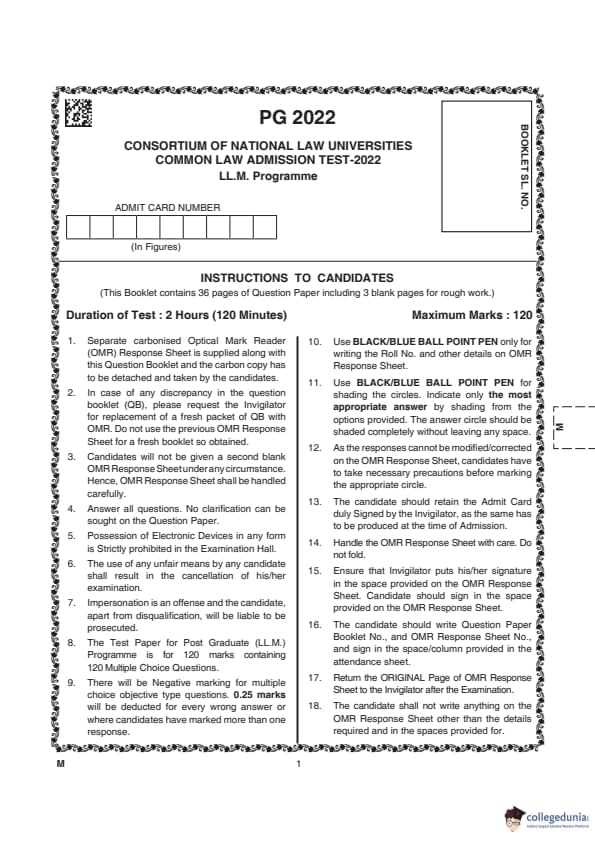
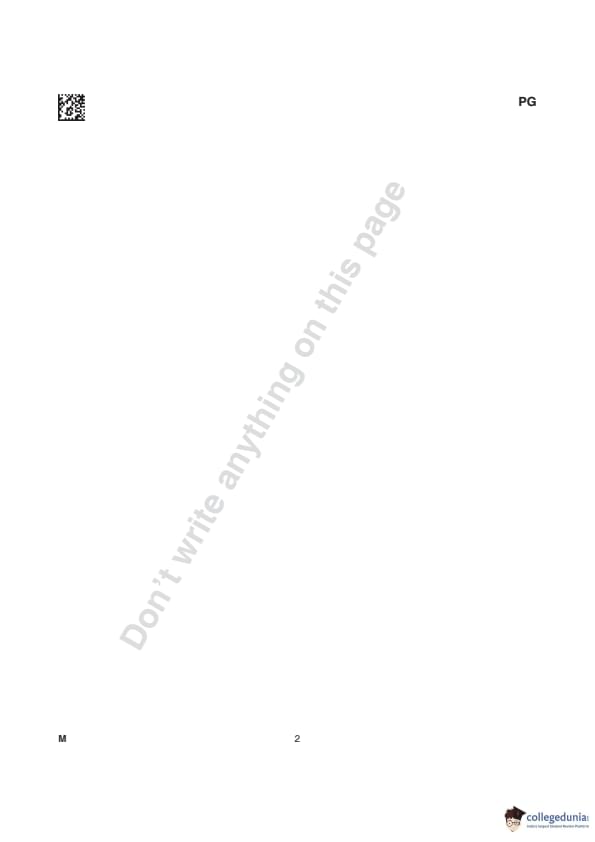
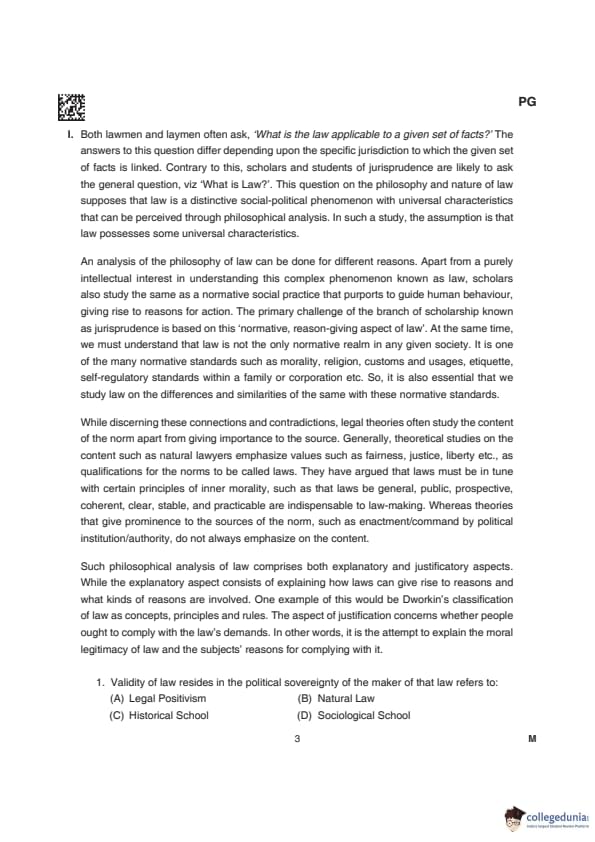
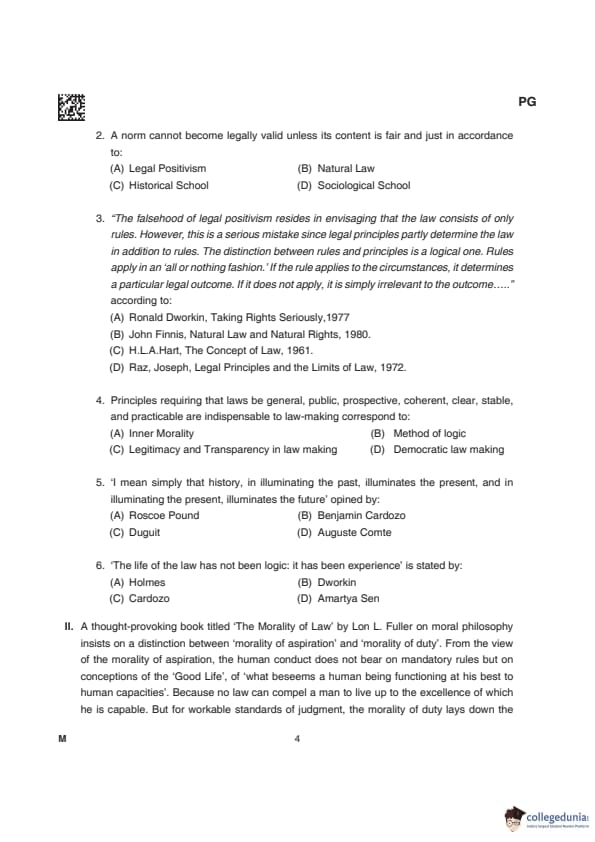
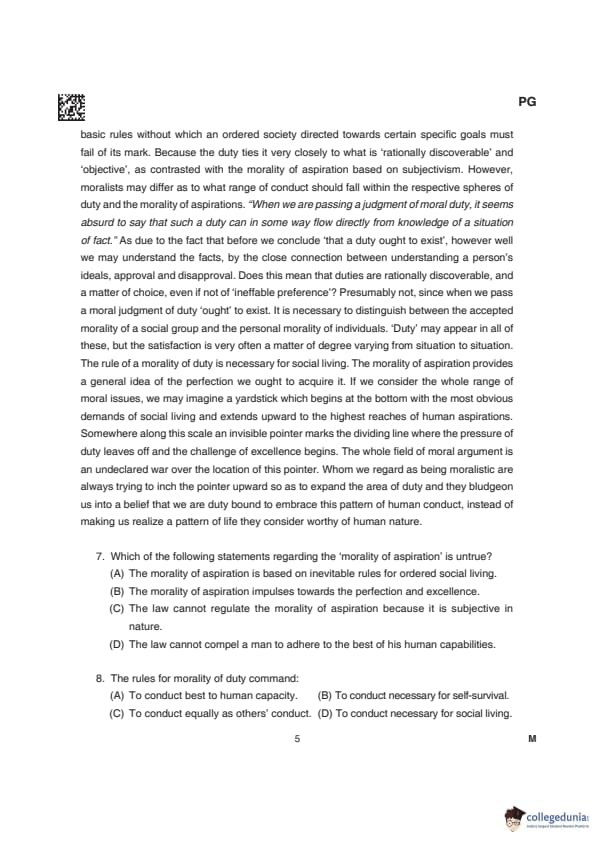
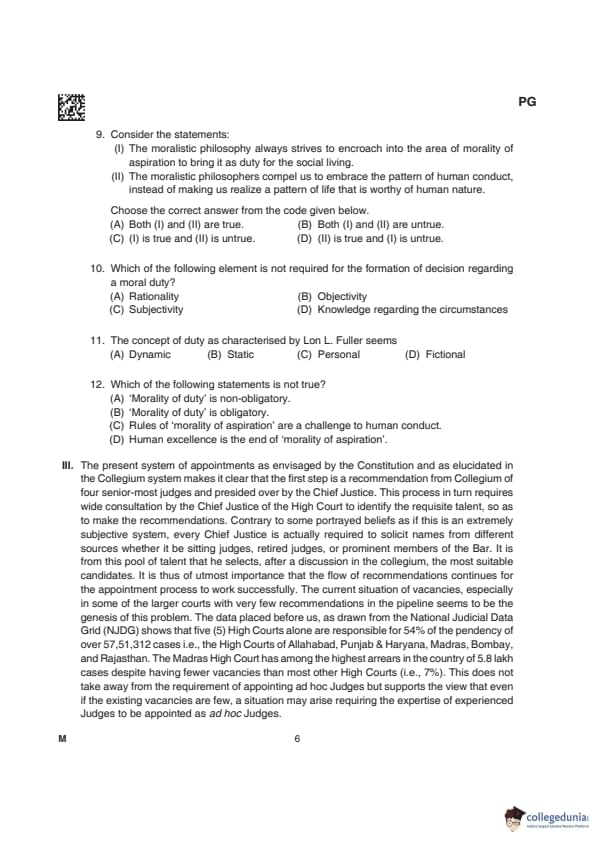
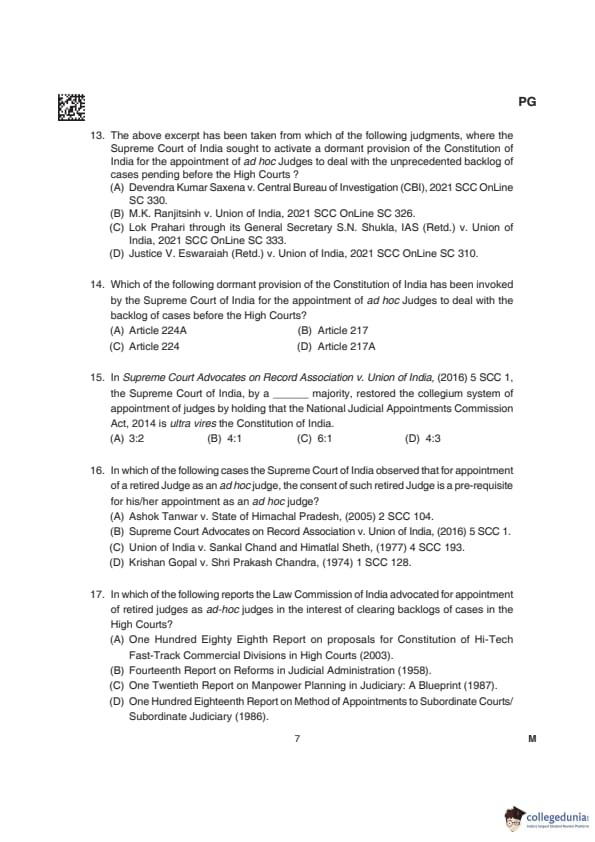
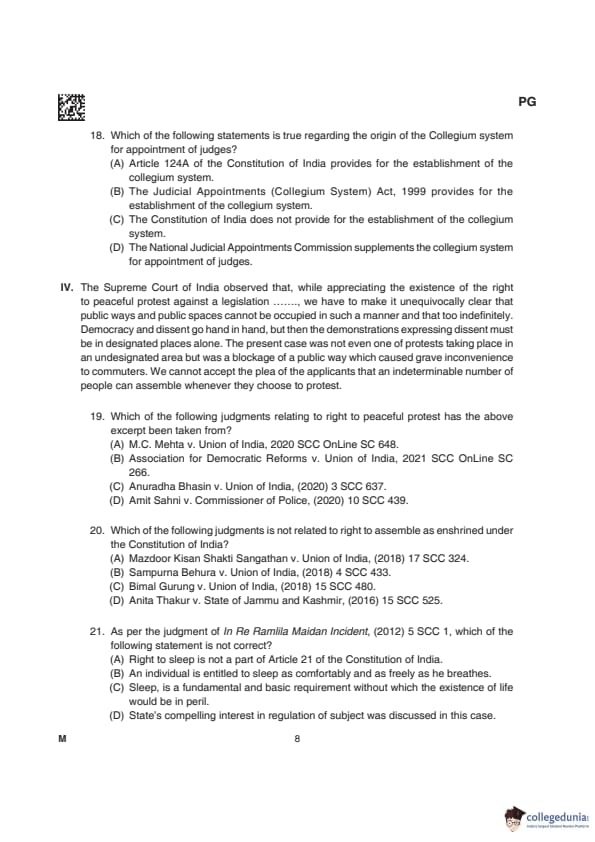
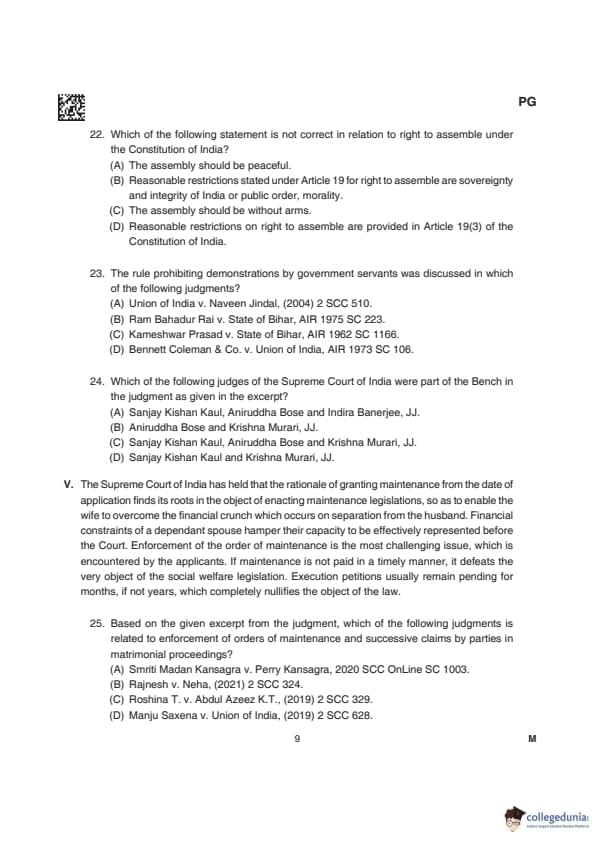
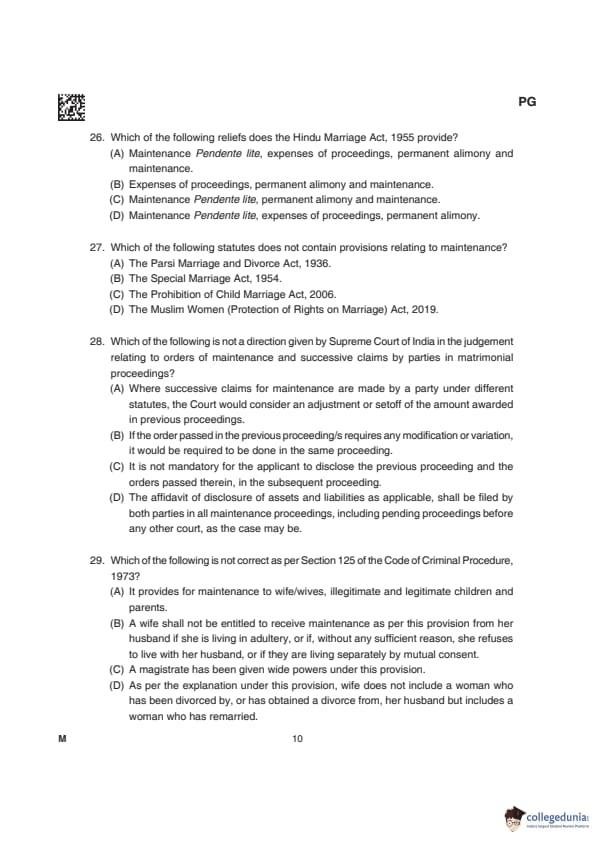
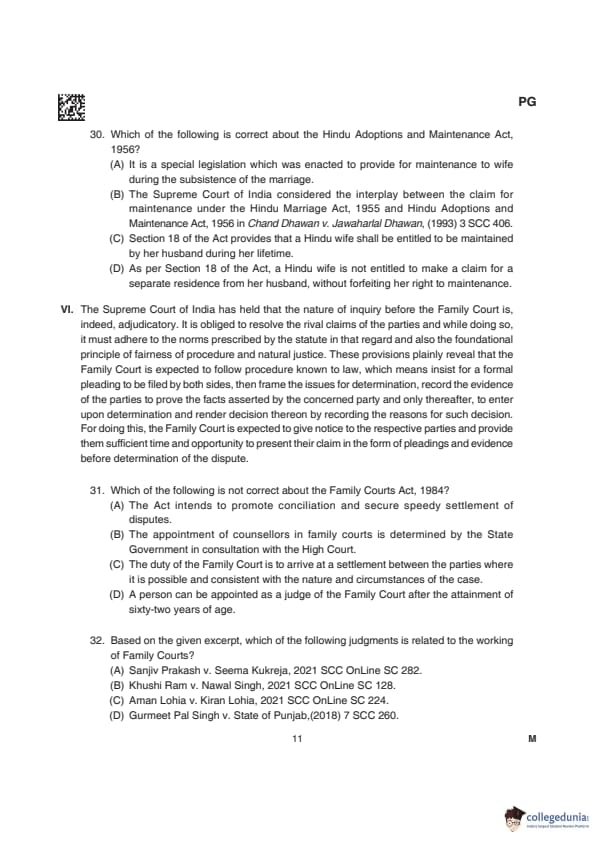
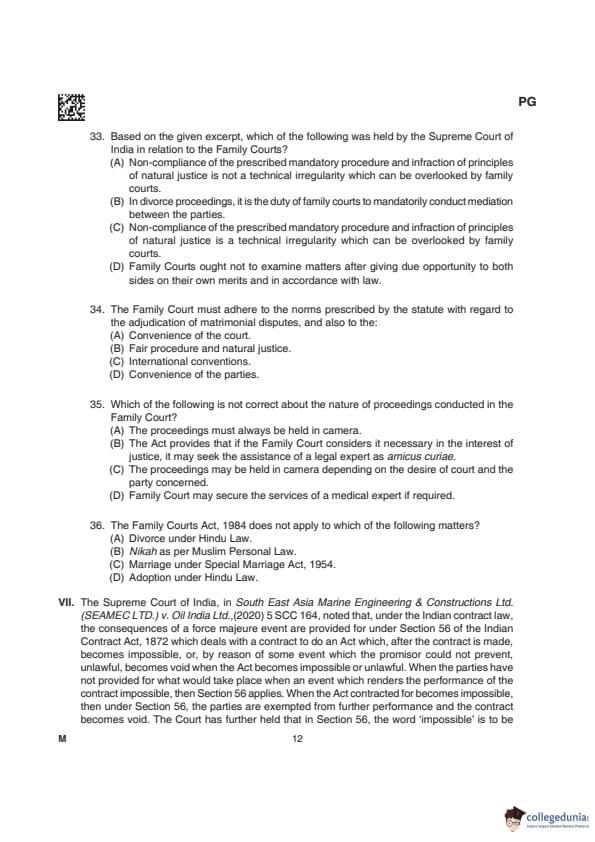
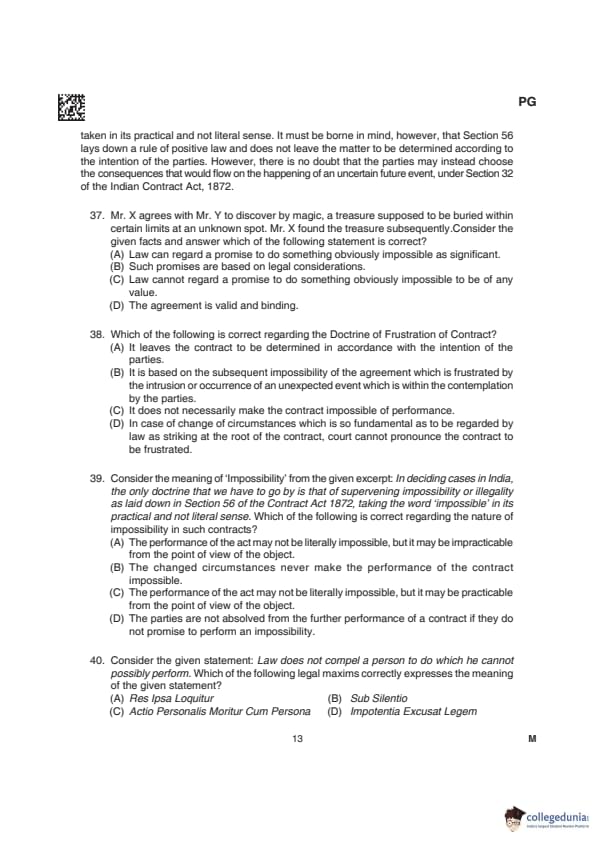
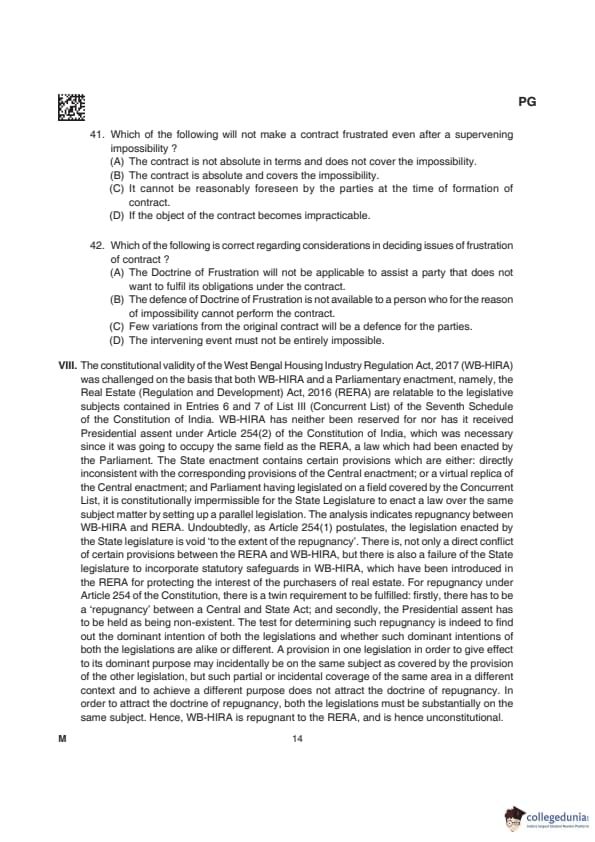
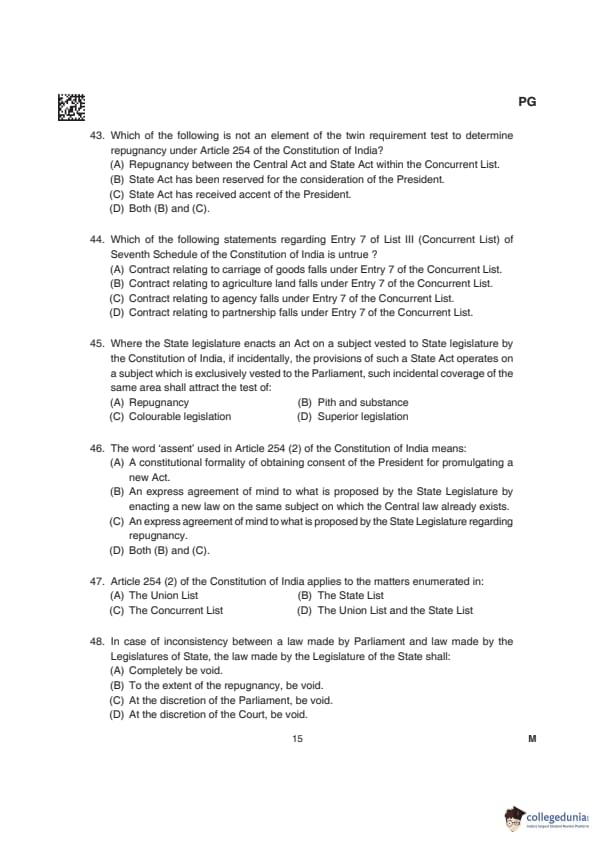
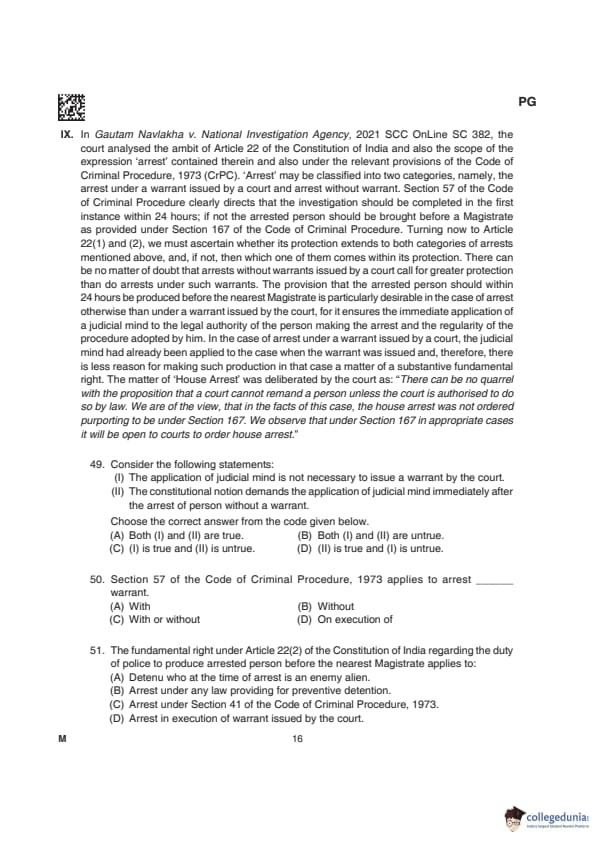
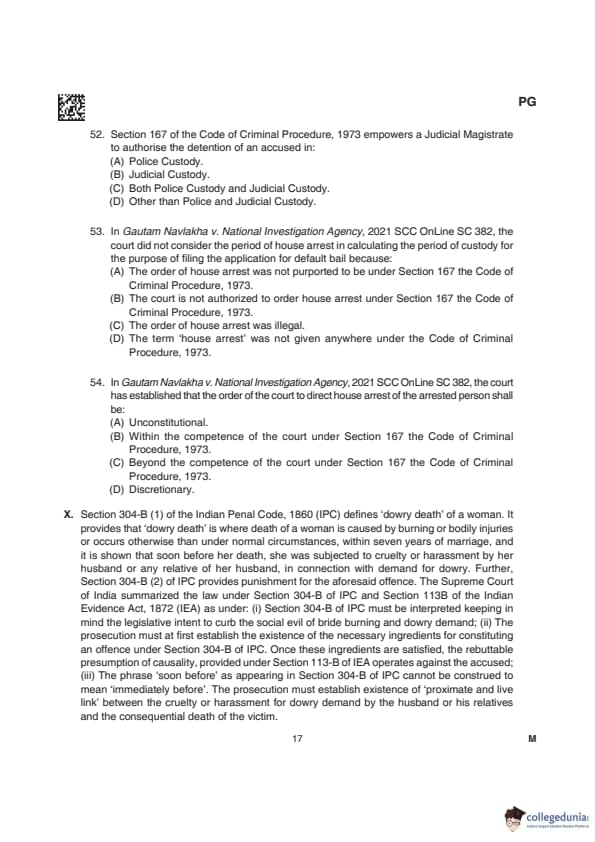
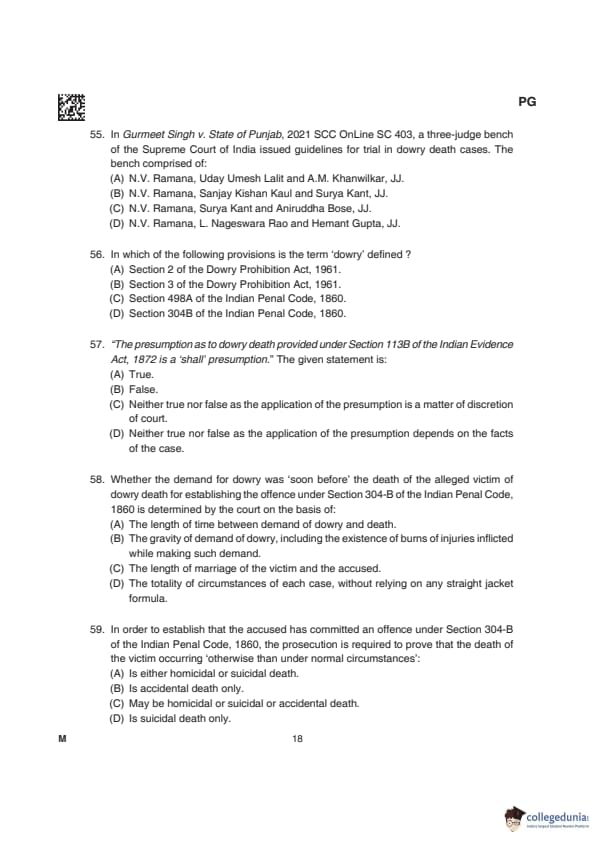
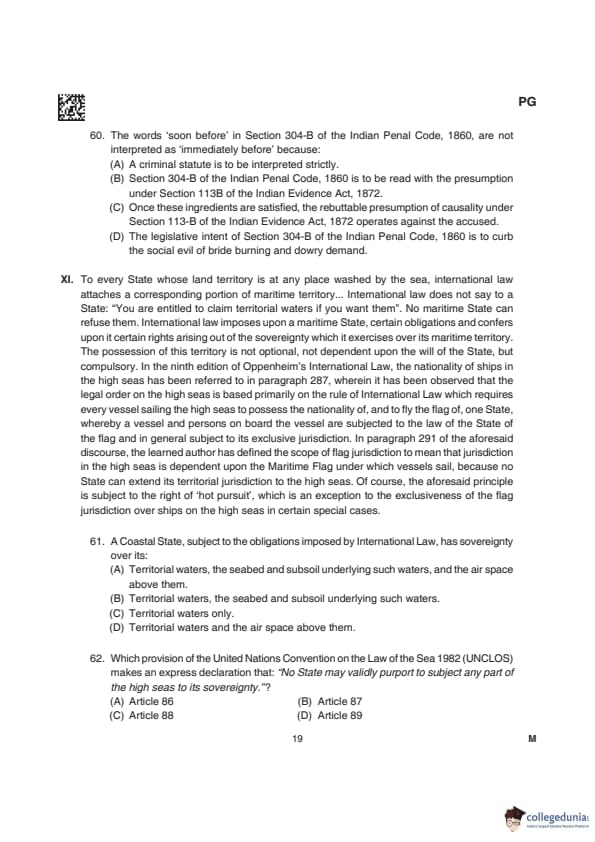
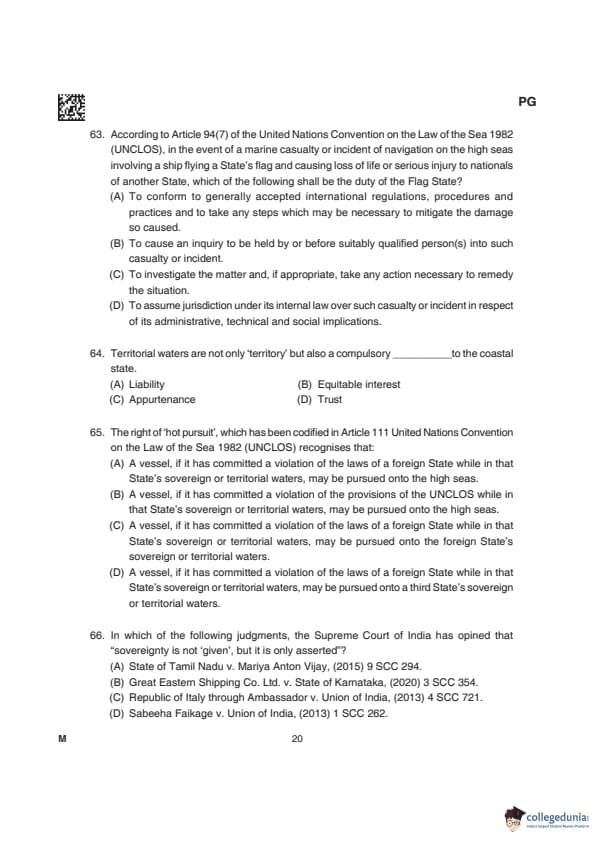
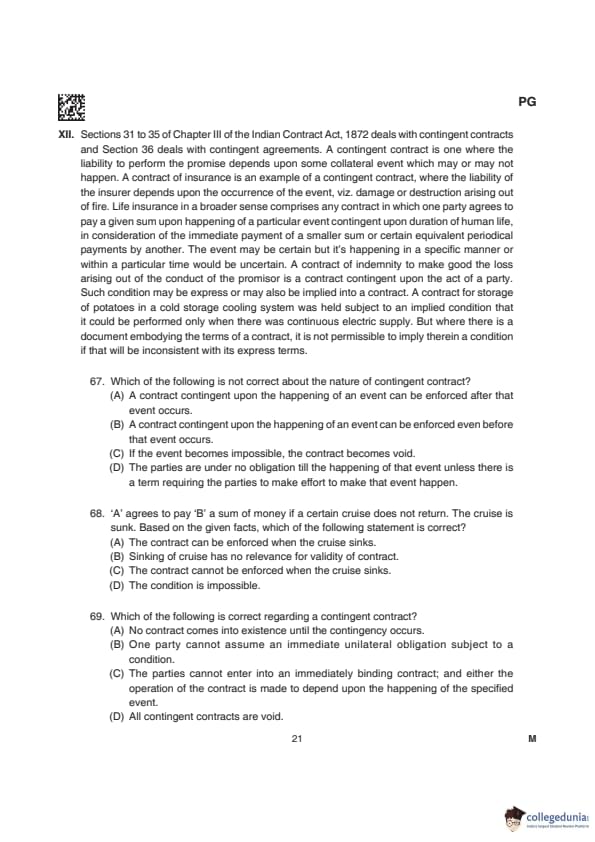
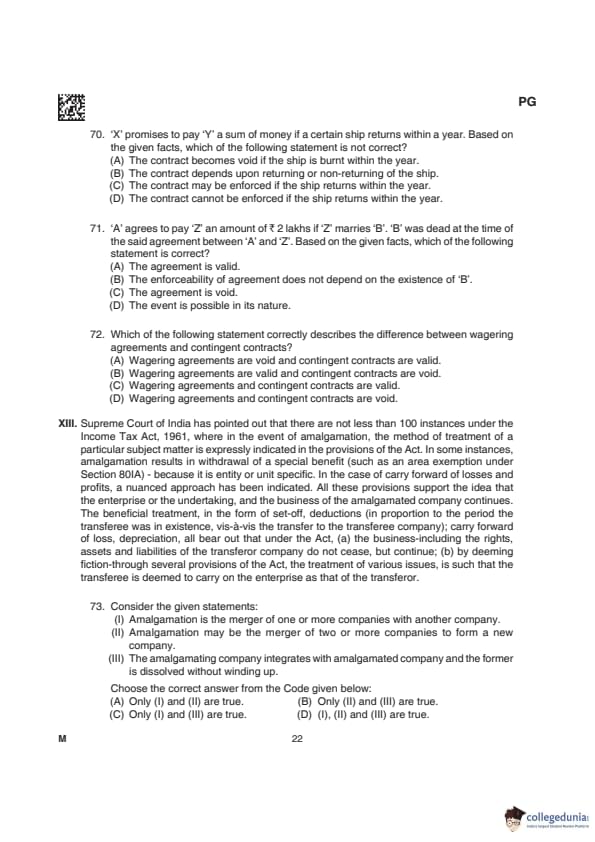
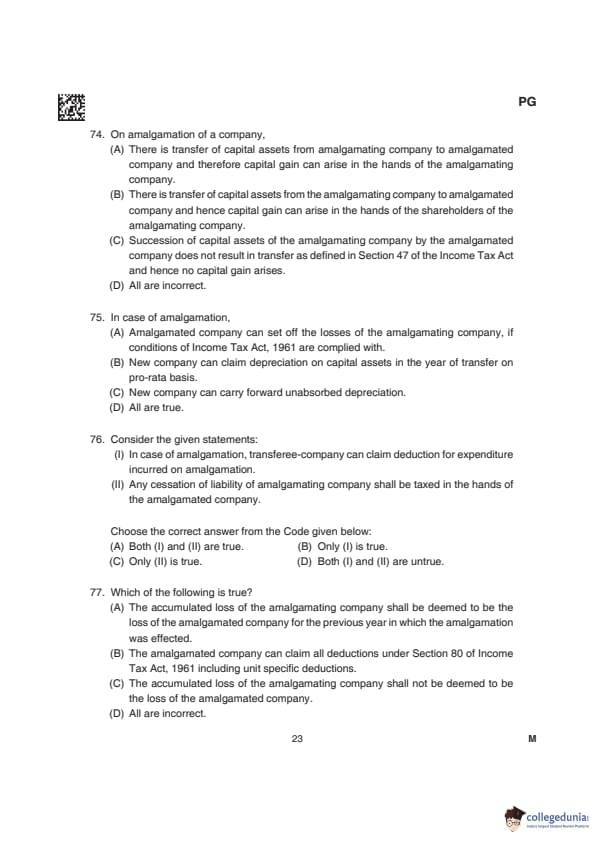
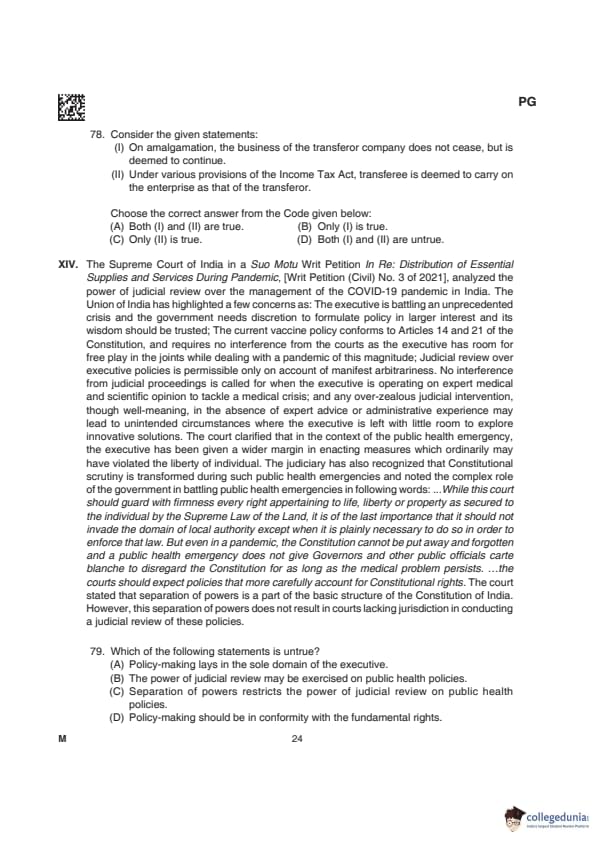
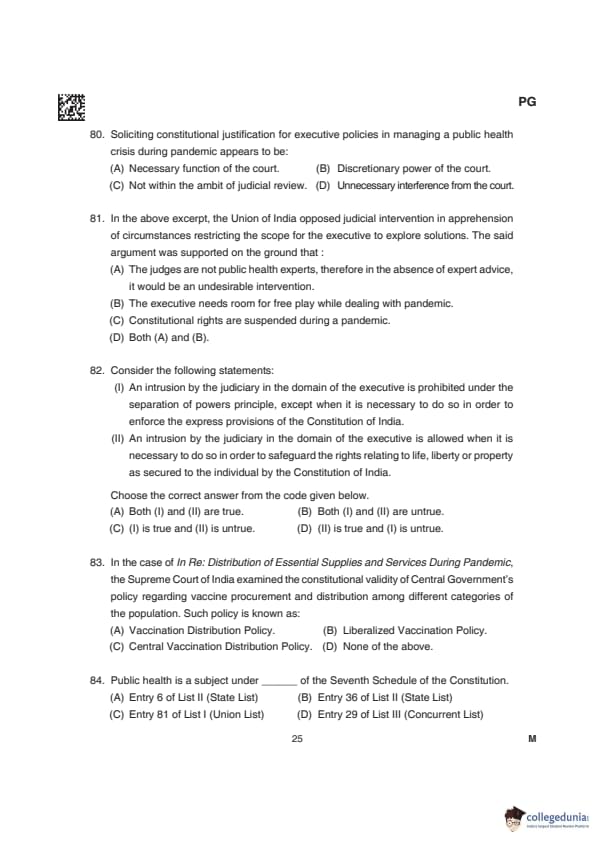
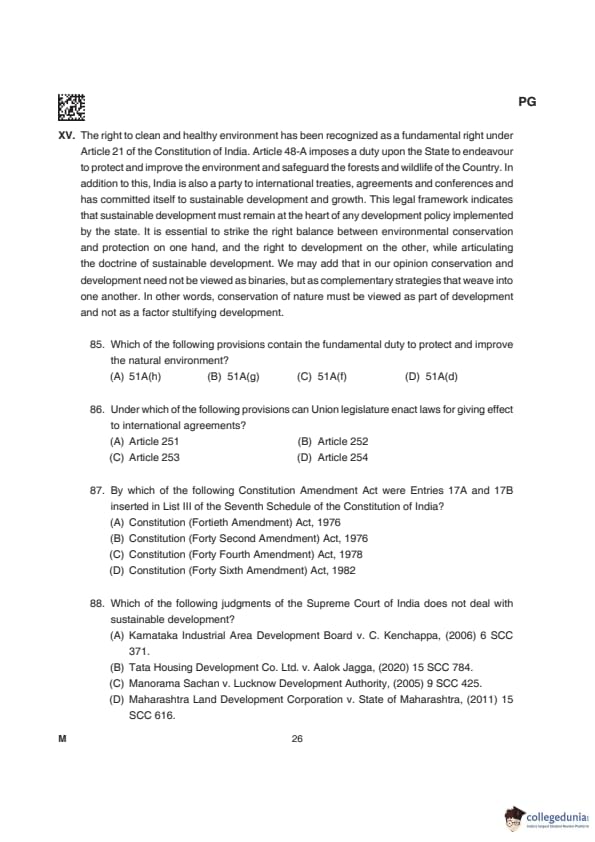
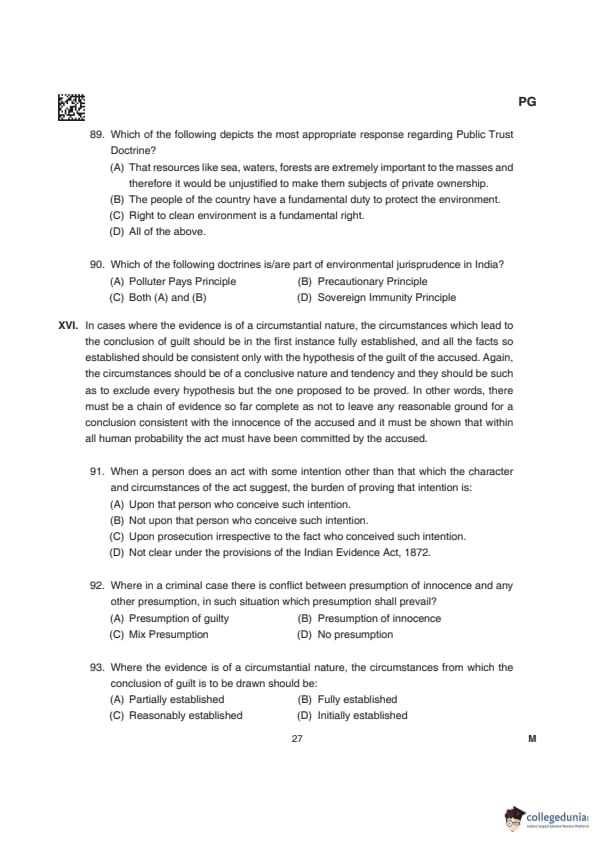
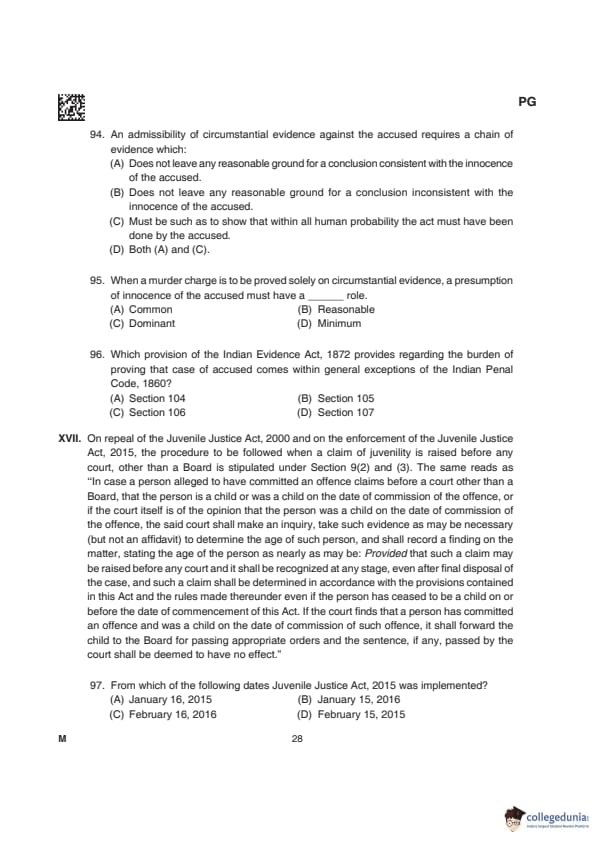
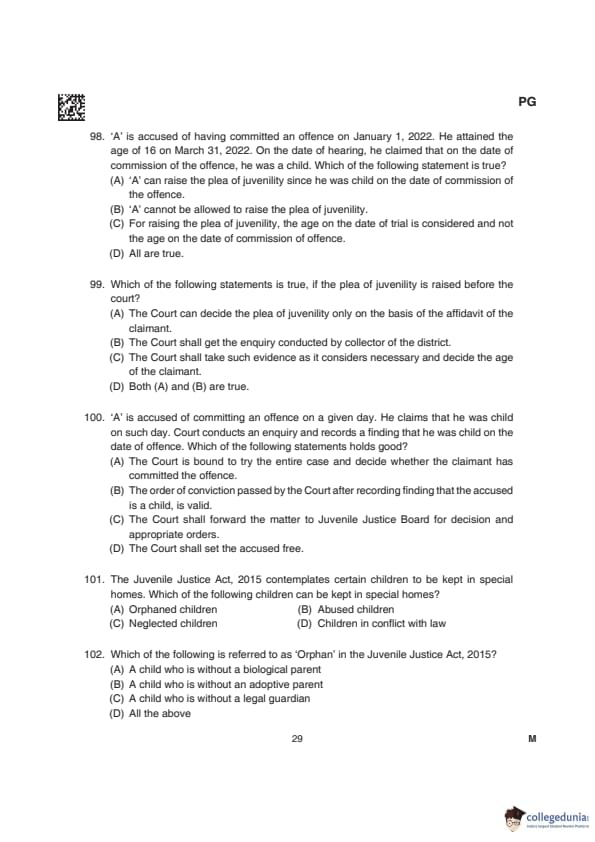
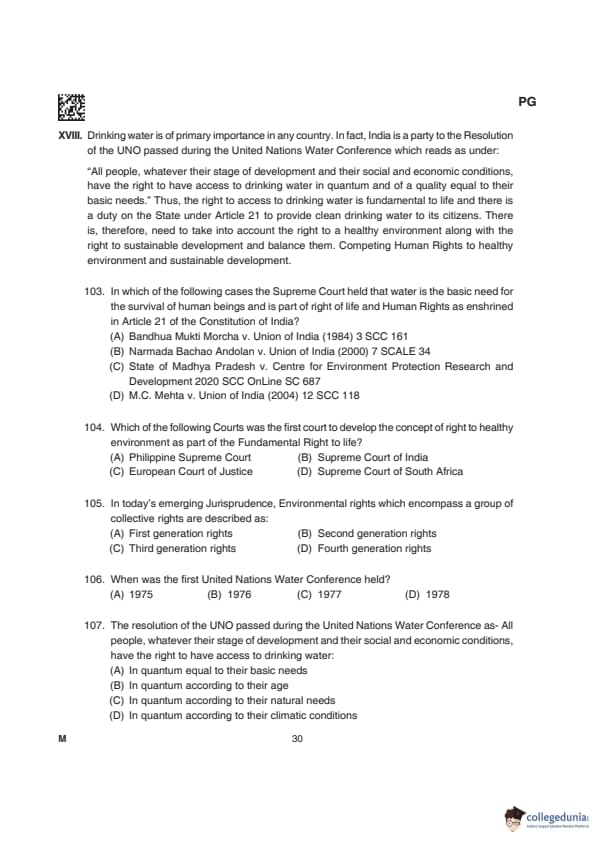
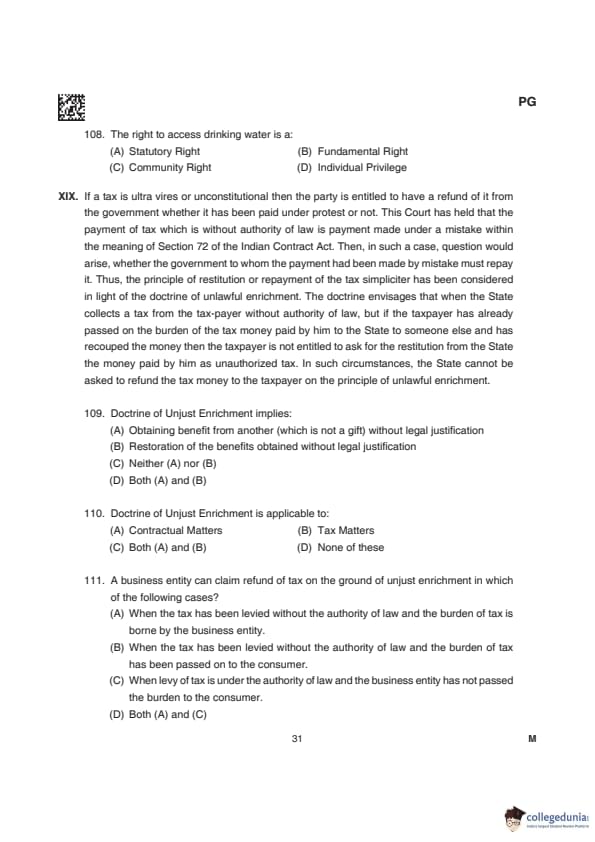
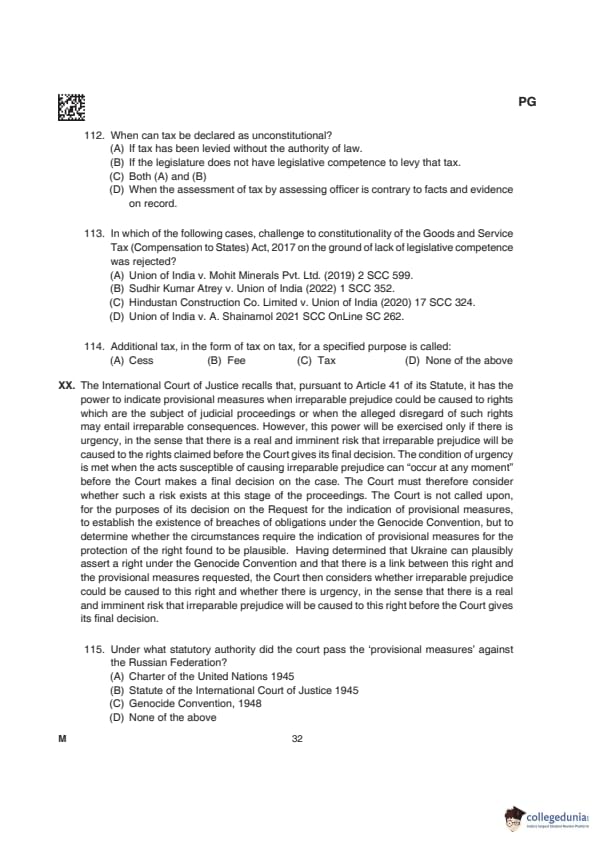
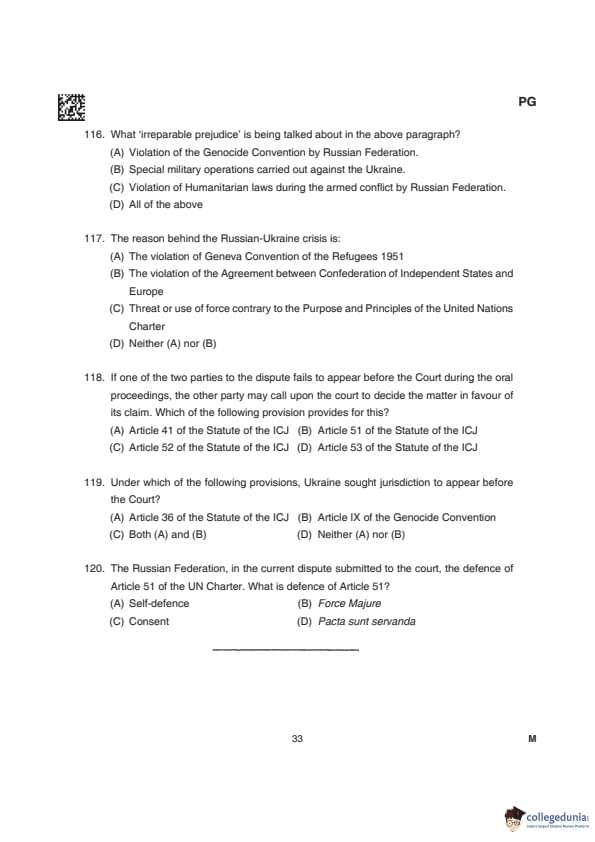
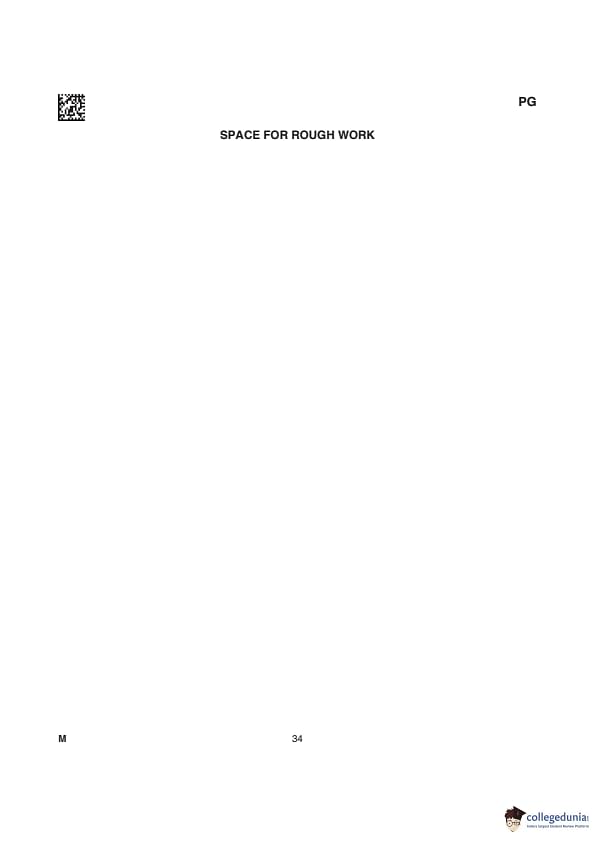
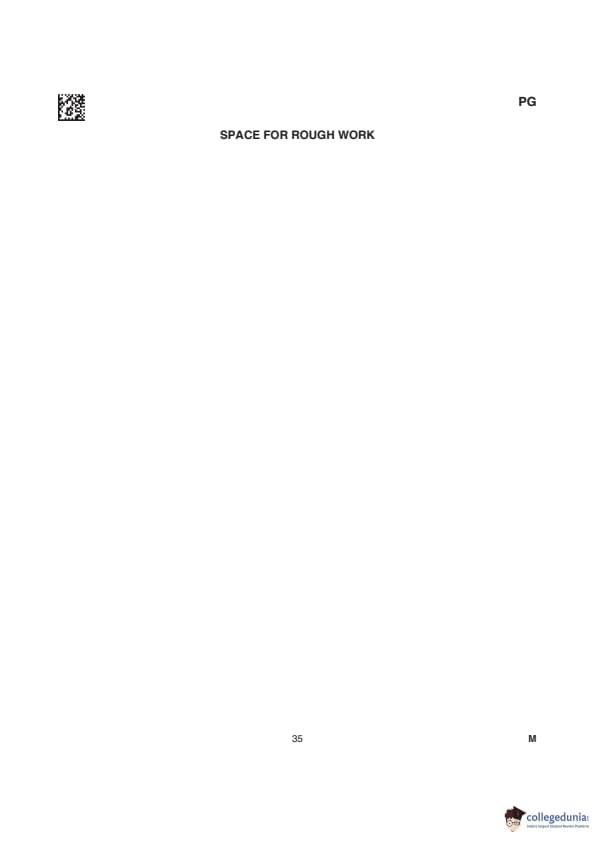
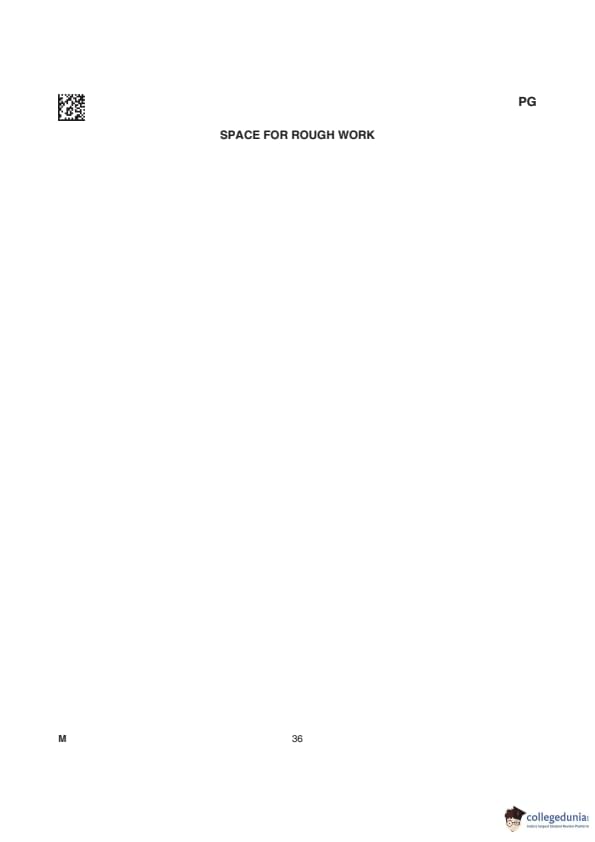
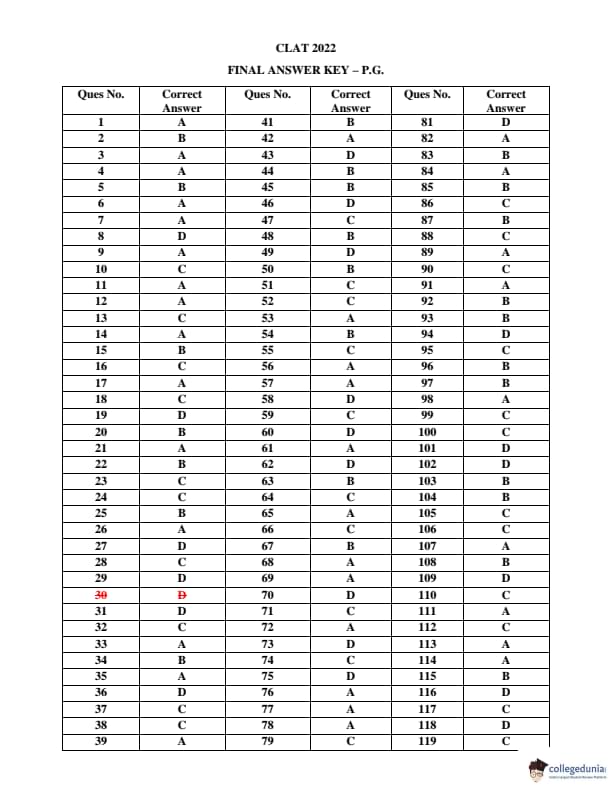
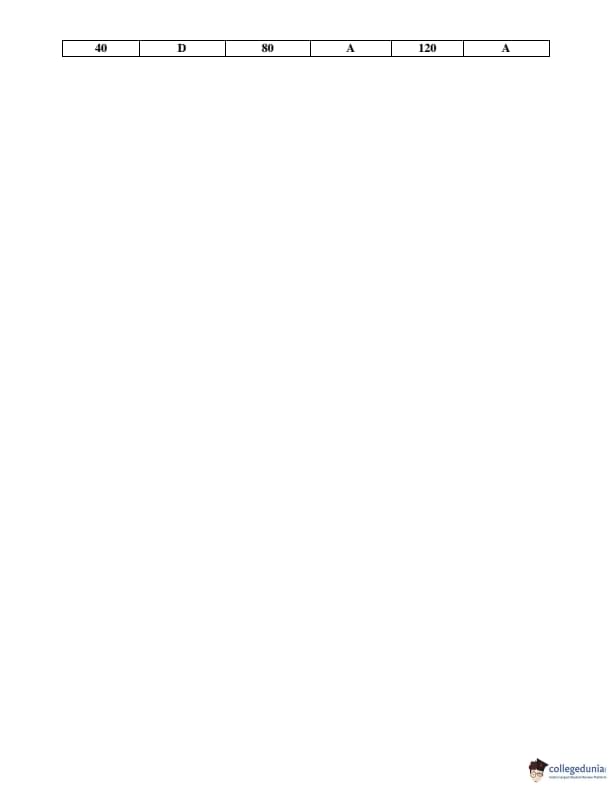
CLAT PG Previous Year Question Paper with Answer Key PDFs
| CLAT PG 2023 Question Paper | CLAT PG 2021 Question Paper |
| CLAT PG 2020 Question Paper | CLAT PG 2019 Question Paper |






Comments